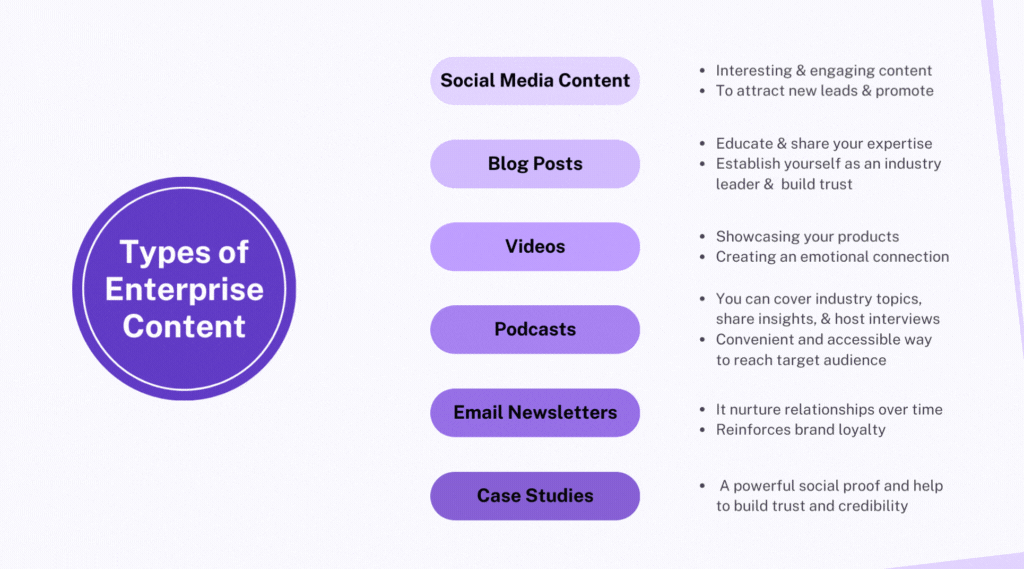Introduction
Content marketing can be difficult, and enterprise content marketing can be even more challenging. According to a study, only 17% of marketers consider content as a stand-alone strategy for marketing, while 60% integrate content into the overall marketing, sales, or communication strategy. A small percentage (5%) have a stand-alone strategy for all content produced by the company, and 2% integrate content into another strategy. The remaining 14% either don’t have a content strategy or are unsure of it.
Regardless of the strategy you choose, you need content marketing to drive leads to your business. This can be a daunting task, especially when you have a lot on your plate managing your team, marketing efforts, and their performance. However, it is crucial for the success of your business.
Let’s explore more about enterprise content marketing!
What is enterprise content marketing?
Enterprise content marketing is a strategic approach used by large organizations to engage their target audience and promote business growth by creating and distributing valuable content. This involves planning, creating, distributing, sharing, and measuring content across various channels to achieve business objectives and target audiences at different stages of the customer journey.
This approach is important because it helps to establish brand awareness, build trust and loyalty among consumers, while also supporting sales and marketing efforts in a scalable and cost-effective manner.
What are the common types of enterprise content marketing to adopt in 2024?
Enterprise content strategies vary depending on the organization’s goals and target audience.
Here are some of the most common types of enterprise content strategies:

- Social media content
- Blog posts
- Videos
- Podcasts
- Email newsletters
- Case studies
Let’s understand the types shortly.
1. Social media content
When it comes to social media, creating content that’s interesting and engaging can go a long way in attracting new leads and promoting your brand.
By showcasing your brand, services, or products in a fun and creative way, you can catch the eye of your target audience and encourage them to interact with you. This can help spread the word about your brand and ultimately lead to more success for your business.
2. Blog posts
Blogging is a great way to share your expertise and educate your audience. By publishing informative and relevant articles, you can establish yourself as an industry leader and build trust with your readers.
A well-crafted blog post can address common pain points and offer solutions that guide your audience through their journey. It’s a powerful tool for nurturing leads and building relationships with your audience.
3. Videos
The use of video content can help you establish a more personal connection with your audience. By leveraging a free online video editor, you can easily create visually appealing and engaging material that effectively communicates information, builds an emotional connection, and fosters brand loyalty.
Videos can be a powerful tool for engaging your audience through:
- showcasing your products
- providing a glimpse behind the scenes
- sharing customer testimonials
4. Podcasts
Creating audio content in the form of podcasts allows you to reach and engage with your target audience in a convenient and accessible way.
Podcasts offer valuable content that can be consumed on demand, catering to the preferences and lifestyles of your audience by covering industry topics, sharing insights, and hosting interviews.
5. Email newsletters
Sending regular newsletters to subscribers is an effective way to stay connected with your audience and nurture relationships over time.
Whether you’re sharing updates, promotions, or educational content, email newsletters provide a direct channel for communication and help reinforce brand loyalty while keeping your audience informed and engaged.
6. Case studies
Sharing real-life examples of how your products or services have positively impacted customers allows you to demonstrate your value proposition in a tangible and relatable manner.
Case studies serve as powerful social proof and help build trust and credibility by showcasing your ability to deliver results and solve specific challenges your target audience faces.
How do you develop and implement an effective content marketing strategy for your business?
Creating an enterprise content strategy involves developing a comprehensive plan for using content to achieve business objectives and engage the target audience effectively.
Here are the steps involved:
- Define your goals
- Understand your audience
- Conduct a content audit
- Develop a content plan
- Create a content calendar
- Allocate resources
- Create and distribute content
- Measure and optimize
Let’s understand these steps involved in enterprise content marketing strategy.
1. Define your goals
Start by identifying what you want to achieve with your content strategy. This could include increasing brand awareness, generating leads, improving customer engagement, or driving sales.
2. Understand your audience
Conduct research to understand your target audience’s needs, preferences, and pain points. Creating buyer personas can help tailor your content to match their interests and behaviors.
3. Conduct a content audit
Review your existing content to assess what’s working and what isn’t. This will help you identify gaps in your content library and opportunities for improvement.
4. Develop a content plan
Based on your goals and audience insights, create a content plan that outlines the types of content you will produce, the channels you will use for distribution, and the frequency of publication.
5. Create a content calendar
Organize your content production and publication schedule with a content calendar. This helps ensure a consistent flow of content and aligns your team’s efforts.
6. Allocate resources
Determine the resources required to execute your content strategy, including team roles, content creation tools, and budget for content promotion.
7. Create and distribute content
Start producing high-quality, relevant content that resonates with your audience. Use a mix of formats and channels for distribution to reach your audience where they are most active.
8. Measure and optimize
Continuously monitor the performance of your content against your goals. Use analytics to understand what’s working and make data-driven decisions to refine and optimize your content strategy over time.
What are the challenges in enterprise content marketing and how to overcome them?
Enterprise content marketing, while potentially highly effective, comes with its own set of challenges.
Here are some common challenges and strategies to overcome them:
- Content scale and consistency
- Audience engagement and personalization
- Resource allocation and budget constraints
- Measuring ROI and demonstrating value
- Content distribution and amplification
- Staying ahead of trends and competition
- Maintaining brand consistency and compliance
Let us understand each of them in detail:
1. Content scale and consistency
- Enterprises often have a large volume of content to manage across various platforms, which can lead to inconsistencies in messaging and quality.
- To overcome this, establish a content calendar that outlines themes, topics, and publication schedules.
- Invest in content management systems (CMS) that facilitate collaboration and streamline the content creation process.
2. Audience engagement and personalization
- Enterprises may struggle to engage their target audience effectively, especially when dealing with diverse customer segments.
- Utilize data analytics to understand audience behavior and preferences, allowing for more personalized content.
- Implement marketing automation tools to deliver targeted content based on user interactions and demographics.
3. Resource allocation and budget constraints
- Content marketing initiatives often require significant resources, including manpower, time, and budget.
- Allocate resources efficiently by prioritizing high-impact content initiatives and leveraging existing assets.
- To optimize resource utilization, consider outsourcing specific tasks, such as content creation or analytics, to specialized agencies or freelancers.
4. Measuring ROI and demonstrating value
- Demonstrating the ROI of content marketing efforts can be challenging, particularly in enterprises with complex sales cycles and multiple touchpoints.
- Set clear objectives and key performance indicators (KPIs) aligned with business goals, such as lead generation, brand awareness, or customer retention.
- Utilize advanced analytics tools to track and measure the impact of content across the entire customer journey.
5. Content distribution and amplification
- Creating great content is only half the battle; ensuring it reaches the right audience is equally important.
- Develop a multi-channel distribution strategy that leverages owned, earned, and paid media channels to amplify reach.
- Partner with influencers, industry publications, and relevant communities to extend the reach of your content through partnerships and collaborations.
6. Staying ahead of trends and competition
- Enterprises need to stay updated with the latest trends and technologies in content marketing.
- Invest in continuous learning and professional development so your team can stay ahead of the curve.
- Monitor competitor strategies and industry trends to identify opportunities for innovation and differentiation.
7. Maintaining brand consistency and compliance
- Enterprises operating in regulated industries or with multiple brands face challenges maintaining brand consistency and compliance across all content assets.
- Develop comprehensive brand guidelines and governance processes to ensure consistency in messaging, tone, and visual identity.
- Implement compliance checks and approvals to mitigate the risk of regulatory violations or brand reputation damage.
How can Revv Growth help you create your enterprise content strategy?
Creating a strategy for your business’s content can be tough. You need to know a lot about your industry and have the right skills and experience. If you’re a SaaS business, you might not have everything you need to make the best plan for your content marketing.
But Revv Growth can help. We are experts in making strategies for businesses like yours. We know how to make a plan that fits your goals and who you’re trying to reach. So why wait? Connect with us today!



